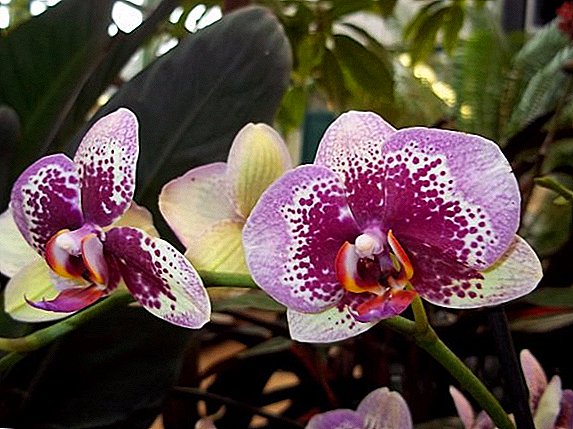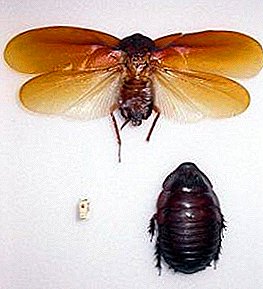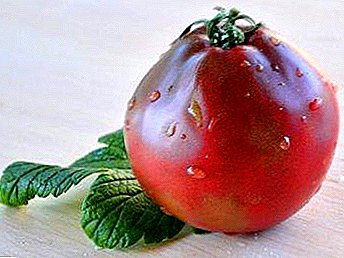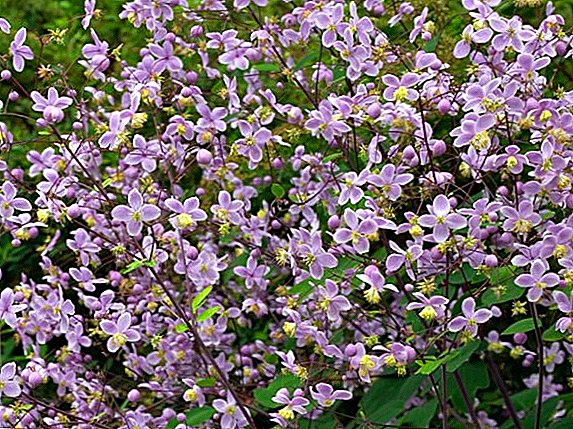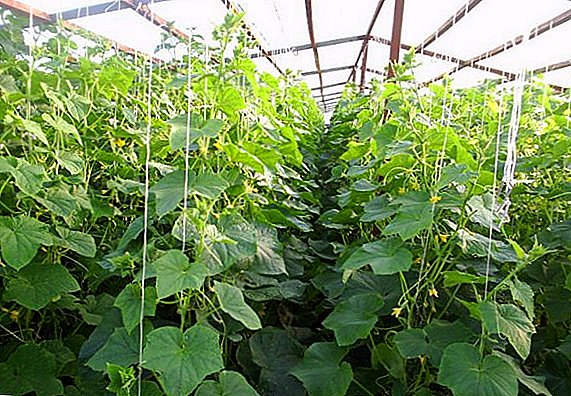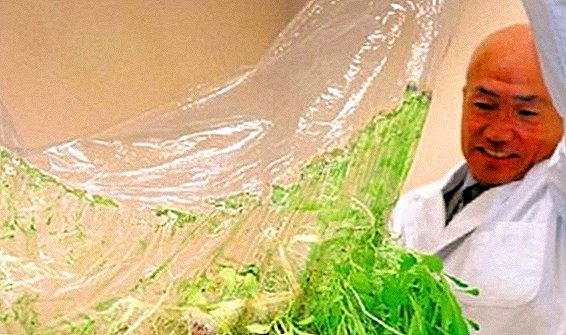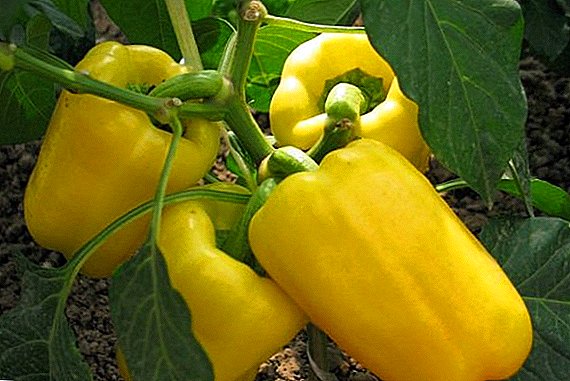 Most often, gardeners are looking for productive varieties of tomatoes and cucumbers, forgetting that other plants planted on the site, can also bring a big harvest and still have improved taste.
Most often, gardeners are looking for productive varieties of tomatoes and cucumbers, forgetting that other plants planted on the site, can also bring a big harvest and still have improved taste.
Today we will discuss the pepper "Gemini", we will learn the characteristics and description of this variety, the agricultural technician of its cultivation.
Description and photo
Let's start with an external description of the plant, and also talk about the distinctive features of the fruit, we indicate the main parameters. 
Bushes
Pepper "Gemini" has a mid-height above-ground part, reaching a height of 0.6 m. The sheet plates are wrinkled and have a dark green color. A large number of leaves protects the fruit from sunlight.
The bush has a powerful upright stalk that does not allow the plant to "lie down" when fruits begin to form.
Fruit
The fruits are colored bright yellow and have a cuboid shape. The average fruit weight is 200 g in open ground and about 300 g in closed ground.
Important! During removable maturity, the fruits are green.
The wall thickness of the fruit is 8 mm. It is separated from the stalk without effort.  It is worth noting that the fruits have a good taste, even if they were collected before full maturity, during technical maturity. Fully ripened pepper has an excellent sweet taste with a barely noticeable bitterness.
It is worth noting that the fruits have a good taste, even if they were collected before full maturity, during technical maturity. Fully ripened pepper has an excellent sweet taste with a barely noticeable bitterness.
Fruits during removable maturity can be used for any purpose, but they are still more suitable for preservation, and fully ripened options are best used fresh.
Check out also such varieties of peppers as Soloist, Golden Miracle, Swallow, Atlant, Kakadu, Bulls Ear, Anastasia, Claudio, Ratunda, Habanero, "Gypsy", "Hero".
Characteristic variety
Before us is an early hybrid variety, which gives a harvest on the 78th day after the pickling of the seedlings. It is resistant to the most common diseases. On one bush tied up to 10 fruits of impressive size.
The hybrid is suitable for both closed and open ground, so "Gemini" can be grown even in cold climates, receiving a large number of fruits. 
Advantages and disadvantages
Pros:
- early harvest and simultaneous ripening of most fruits;
- excellent presentation and impressive size;
- good taste regardless of whether the pepper is harvested at the time of marketability or real maturity;
- compact overhead part;
- resistance to viral diseases;
- good yield.
Did you know? Pepper after heat treatment saves vitamins and minerals, which allows you to get everything you need even from canned fruits.Minuses:
- the slow transition from commodity maturity to biological, because of which the pepper partially loses its presentation;
- in the absence of dressings, the fruit walls become much thinner, due to which the hybrid loses to other varieties;
- when a large number of fruits ripen or when grown in a greenhouse, the bush still requires a garter.

Growing seedlings
Next, we will talk about how to properly grow seedlings of the variety "Gemini F1", as well as deal with the basic requirements of planting material at the initial stage.
Timing, optimal soil, sowing
Let's start with the substrate. The seedlings need a very light soil, which will at the same time be quite nutritious and have excellent drainage properties, so we will need to take 2 parts of humus, 1 part of the ground and 1 part of sand.
Mix everything thoroughly and fill the containers.
For germinating seeds need a sufficiently high temperature - 25-27 ° C. The minimum temperature at which shoots are possible is 22 ° C.
If the seedlings will spike in open ground, then it is necessary to sow the seeds in the tank in early March, and in the southern regions - in the II-III decade of February.  If the pepper will be grown in a greenhouse, then you can sow as early as January
If the pepper will be grown in a greenhouse, then you can sow as early as January
Important! Seeds before planting do not require additional processing, as the manufacturer has already taken care of this.
Sowing is done in a pre-moistened soil. At the initial stage, the sowing material does not need to make additional mineral fertilizers.
Mineral fertilizers also include ammophos, monophosphate, Plantafol, Sudarushka, Kemira, ammonium sulfate, and Azofoska.Sowing depth - 2 cm. Deeper seed placement will lead to late shoots, and the plants themselves will be too depleted due to the high resource costs.
Seedling care
After the sowing has been done, it is necessary to moisten the soil, keeping the above temperature and high humidity. If everything was observed, then the first shoots will appear no later than 2 weeks later.  After the appearance of the first greenery, the temperature can be reduced to 24 ° C and the seedlings should be transferred to a well-lit place so that it receives a sufficient amount of light.
After the appearance of the first greenery, the temperature can be reduced to 24 ° C and the seedlings should be transferred to a well-lit place so that it receives a sufficient amount of light.
Important! Water these plants with extremely warm water.
It is worth remembering that the pepper requires at least 12 hours of daylight. In the absence or insufficient amount of light, the bushes are drawn out and deformed.
When the plants have formed the first 2 true leaves, they can be fed with mineral water. To do this, in 1 liter of warm water dilute 0.5 g of ammonium nitrate, 3 g of superphosphate and 1 g of potash fertilizers.
A similar feeding should be repeated after 2 weeks, but the dosage of each component should be doubled. 
Transplanting
Dive seedlings in a greenhouse or open ground should be at the age of 45-50 days, after a quenching. In addition, each plant should have at least 5 well-developed leaves and a height of about 16 cm.
For hardening all the plants a week before planting you need to start to take out into the fresh air, thereby accustoming you to low temperatures, wind and direct sunlight.
Important! Pepper does not like frequent transplants, so the seeds are immediately sown either in single pots or in a container in which there will be a sufficient amount of space.The temperature of the soil during the picking should be at least 13 ° C. If the soil has a lower temperature, then even a strong heat will not save the plant from overcooling the root system.
 As for the soil in which the picking will be carried out, it should be light, slightly carbonate. In this case, predecessors should be optimal crops (cereals or legumes).
As for the soil in which the picking will be carried out, it should be light, slightly carbonate. In this case, predecessors should be optimal crops (cereals or legumes).To achieve maximum yield and optimum planting density, you need to plant the plants according to the scheme 60-80-90 × 35-40-50 cm.
At the same time, the density of planting with drip irrigation for early harvest should be less (30-35 thousand plants per hectare) than with the standard method of cultivation (up to 45 thousand per hectare).
Grade Care
Care involves frequent watering, loosening of the soil, as well as the introduction of dressings and soil mulching.
Mulch
Mulching plants is necessary in order to retain moisture in the soil and protect the roots from temperature changes. Also, mulch will help protect against salinity. 
Top dressing
Fertilizers are applied 3 times: one week after picking, during flowering and at the beginning of the formation of fruits. Enough to make phosphate and potash supplements, and pepper does not need nitrogen.
Important! The plant does not tolerate chlorine, so the "mineral water" should not have this substance in the composition.
Formation
Shrub is formed in 1 stem, side shoots are immediately removed. You also need to cut the first bud.
Garter
If the plant is grown in greenhouse conditions, then it must necessarily require a garter. This is due, primarily, to the weight of the fruits, which in greenhouses reach a mass of 300-350 g.
In the open ground, the fruits are not so "heavy", so the bush can withstand their mass. 
Harvesting and storage of the crop
Pepper can be collected for storage during both technical (commercial) and biological (full) maturity. In the first case, the fruits are removed at the end of July, in the second they are waiting for the appearance of a monochromatic yellow color and collect.
The crop should be stored at a temperature of 7 to 12 ° C.
Did you know? The fruits of pepper reduce blood pressure, therefore, recommended for use by people in old age.
So we finished the discussion of a beautiful and quite popular hybrid of pepper - "Gemini F1". It cannot be said that the plant is perfect, but it gives great fruits that have good taste and are distinguished by a bright color, if you wait for the biological ripeness.  At the same time, the plant is not affected by diseases, which significantly reduces processing costs and increases the final yield. Use the information provided to grow healthy plants that will delight you with large and tasty fruits.
At the same time, the plant is not affected by diseases, which significantly reduces processing costs and increases the final yield. Use the information provided to grow healthy plants that will delight you with large and tasty fruits.




